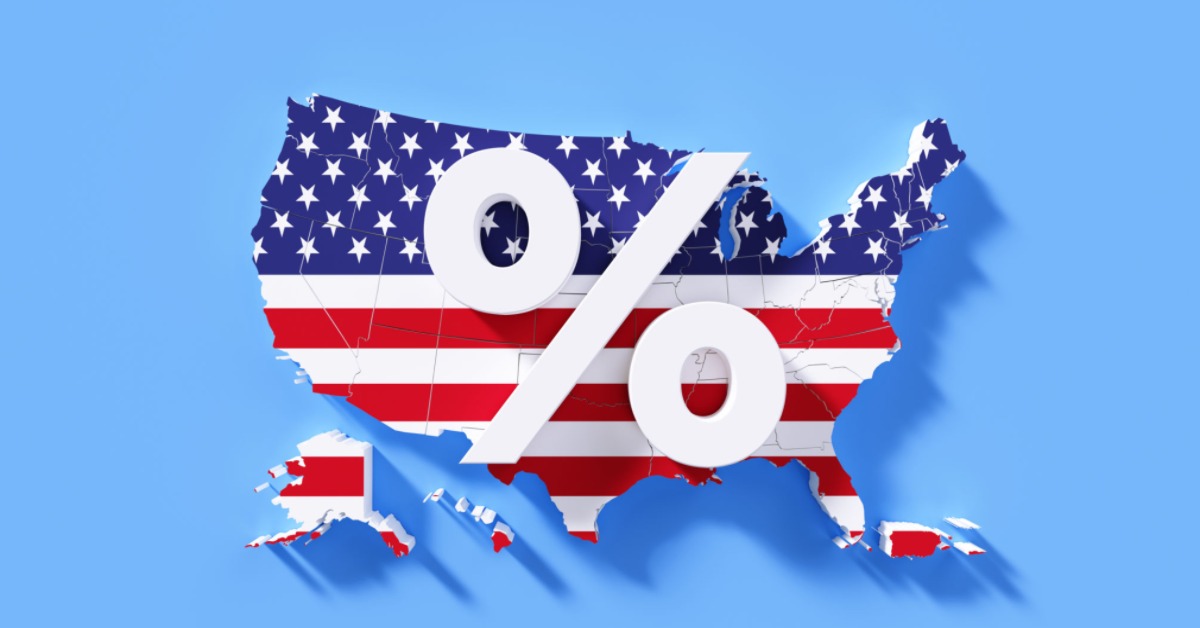Want to find the states with the cheapest mortgage rates? As of July 9, 2025, the states offering the lowest 30-year new purchase mortgage rates are New York, California, Georgia, Texas, Washington, Indiana, New Jersey, and Colorado. These states boast rate averages between 6.69% and 6.85%. Let's dive deeper into what's influencing these rates and what it means for you.
While national averages give you a general idea, the real story lies in the state-by-state variations. Understanding these differences can save you a significant amount of money over the life of your loan!
Mortgage Rates Today: The States Offering Lowest Rates – July 9, 2025
The Best States for Low Mortgage Rates: A Closer Look
According to Investopedia's report and Zillow's data, here's a quick recap of the states offering the most attractive mortgage rates today:
- New York
- California
- Georgia
- Texas
- Washington
- Indiana
- New Jersey
- Colorado
These states present a more favorable environment for potential homebuyers seeking to minimize their borrowing costs. This is beneficial for people looking to buy their homes in these states.
On the Other End: States with Higher Mortgage Rates
It's just as important to know where rates are higher. On July 9, 2025, the following states registered the most expensive 30-year new purchase rates:
- Alaska
- West Virginia
- Vermont
- Wyoming
- North Dakota
- Mississippi
- Delaware
- Nebraska
These states saw averages between 6.93% and 7.05%. While the difference seems small, even a fraction of a percent can add up to thousands of dollars over the life of a 30-year mortgage.
What's Behind These State-by-State Mortgage Rate Differences?
“Why the wide variation in mortgage rates across different states, despite operating under similar macroeconomic circumstances?” That's the million-dollar question, isn't it? Here are a few key factors that come to mind:
- Variations in Credit Scores: States with generally higher average credit scores tend to see lower rates, as lenders perceive less risk.
- Average Loan Size: Larger loan amounts can sometimes (but not always) translate to slightly better rates due to economies of scale for the lender.
- State-Level Regulations: Each state has its own set of rules and regulations governing the mortgage industry, affecting lender operations and pricing.
- Lender Risk Management: Believe it or not, the risk tolerance of lenders plays a major role. Some lenders might be more aggressive in certain states, offering lower rates to gain market share.
- Competition: Plain and simple: more competition is usually better for the buyer. More lenders in a state could mean more competitive rates.
It's important to remember that these factors can work together in complex ways, making it difficult to point to one single cause for rate differences.
Navigating the National Mortgage Rate Trends
After a brief dip to a nearly three-month low a couple of weeks prior, rates on 30-year fixed-rate mortgages have been inching upwards for the past four days, reaching an average of 6.87% as of today.
While rates are still better than mid-May's one-year high of 7.15%, they're not quite as attractive as they were in March when they hit a low of 6.50%. For context, rates bottomed out in September of last year at a two-year low of 5.89%.
National averages of lenders' best mortgage rates
| Loan Type | New Purchase |
|---|---|
| 30-Year Fixed | 6.87% |
| FHA 30-Year Fixed | 7.55% |
| 15-Year Fixed | 5.88% |
| Jumbo 30 Year Fixed | 6.87% |
| 5/6 ARM | 7.51% |
Don't Settle for the First Rate You See: The Importance of Shopping Around
One thing I can't stress enough is the importance of shopping around. Don't just grab the first rate you're offered! Lenders have different appetites in different regions, and they also have different risk models.
- Get quotes from at least three to five lenders. This gives you a good baseline for comparison.
- Consider working with a mortgage broker. They can access a wider range of lenders than you might be able to on your own.
- Check with local credit unions. Sometimes they offer better rates than the big national banks.
Remember, these are average rates. Your actual rate will depend on your financial situation.
Decoding Teaser Rates: What You Need to Know
You've probably seen those incredibly low mortgage rates advertised online. They're tempting, right? But be careful. Those are often “teaser rates,” and they rarely reflect the reality for most borrowers.
These rates might be:
- For borrowers with ultra-high credit scores.
- For smaller-than-typical loans.
- Requiring you to pay points upfront.
Always read the fine print and understand the terms and conditions.
Understanding What Drives Mortgage Rate Fluctuations
Mortgage rates aren't pulled out of thin air! They're influenced by a complex mix of economic factors. Knowing these forces can help you make informed decisions about when to lock in a rate.
Here are the major drivers:
- The Bond Market: Mortgage rates closely track the 10-year Treasury yield. When yields rise, mortgage rates tend to rise as well.
- Federal Reserve Policy: The Fed's actions, especially around bond buying and the federal funds rate (the rate banks charge each other for overnight lending), influence the entire interest rate environment.
- Competition Among Lenders: When lenders are competing fiercely for business, rates can get squeezed down.
- Inflation: Generally, higher inflation equates to higher interest rates, as investors demand higher returns to compensate for the decreasing value of money.
It is very difficult to attribute any change to any one factor. Mortgage rates can be heavily influenced and fluctuate as many of these factors tend to change simultaneously.
Read More:
States With the Lowest Mortgage Rates on July 8, 2025
Are Mortgage Rates Expected to Go Down Soon: A Realistic Outlook
The Federal Reserve’s Current Role in Mortgage Rates and Monetary Policy
The Federal Reserve continues to shape mortgage rates through its monetary policy, though the economic landscape has evolved significantly since the pandemic-era stimulus. Here’s the latest:
Recent Fed Actions and Rate Trajectory
- Rate Cuts in Late 2024: The Fed cut rates three times in late 2024 (September to December), reducing the federal funds rate by 1 percentage point to a target range of 4.25%–4.5%, where it has remained through June 2025 .
- 2025 Outlook:
- The Fed’s June 2025 meeting reaffirmed plans for two rate cuts in 2025, but policymakers are divided on timing and magnitude. Some officials (like Governors Bowman and Waller) advocate for cuts as early as July 2025, while others prefer waiting until September or beyond .
- The “dot plot” shows a median projection of the federal funds rate falling to 3.9% by year-end 2025, with further cuts in 2026–2027 .
Key Influences on Fed Policy
- Tariffs and Inflation: Fed Chair Jerome Powell expects “meaningful” inflation from Trump’s tariffs, though the pass-through to consumer prices has been slower than anticipated. The Fed views this as a temporary shock, not requiring rate hikes, but it complicates the timing of cuts .
- Economic Slowdown: GDP growth is projected at 1.4% for 2025 (down from 1.7%), with unemployment rising to 4.5%. Weak consumer spending and cooling labor markets could prompt cuts later this year .
- Political Pressure: President Trump has repeatedly criticized Powell, demanding aggressive cuts to reduce government debt costs. The Fed has resisted, emphasizing data dependence .
Mortgage Rate Implications
- The 30-year mortgage rate averaged 6.7% in 2024 and remains elevated (~6.8% as of June 2025). Analysts project declines to 5% by 2028 if the Fed follows through on cuts .
- Bond markets currently price in a ~5% chance of a July 2025 cut, with higher odds for September or October .
What’s Next?
The Fed’s next meeting on July 30, 2025 is likely to result in a hold, but policymakers may signal future cuts if labor market weakness or tariff-driven inflation clarity emerges . Longer-term, the Fed anticipates a gradual easing cycle, with rates settling near 2.25%–2.5% by 2027 .
Final Thoughts and Recommendations
As of today, July 9, 2025, New York, California, Georgia, Texas, Washington, Indiana, New Jersey, and Colorado offer the lowest mortgage rates. However, remember that these are just averages. Your individual rate will depend on your credit score, down payment, and other factors.
My advice? Shop around, compare offers, and don't be afraid to negotiate! A little bit of effort can save you a lot of money in the long run.
Invest in Real Estate in the Top U.S. Markets
Investing in turnkey real estate can help you secure consistent returns with fluctuating mortgage rates.
Expand your portfolio confidently, even in a shifting interest rate environment.
Speak with our expert investment counselors (No Obligation):
(800) 611-3060
Also Read:
- Will Mortgage Rates Go Down in 2025: Morgan Stanley's Forecast
- Expect High Mortgage Rates Until 2026: Fannie Mae's 2-Year Forecast
- Mortgage Rate Predictions 2025 from 4 Leading Housing Experts
- Mortgage Rates Forecast for the Next 3 Years: 2025 to 2027
- 30-Year Mortgage Rate Forecast for the Next 5 Years
- 15-Year Mortgage Rate Forecast for the Next 5 Years
- Why Are Mortgage Rates Going Up in 2025: Will Rates Drop?
- Why Are Mortgage Rates So High and Predictions for 2025
- Will Mortgage Rates Ever Be 3% Again in the Future?
- Mortgage Rates Predictions for Next 2 Years
- Mortgage Rate Predictions for Next 5 Years
- Mortgage Rate Predictions: Why 2% and 3% Rates are Out of Reach
- How Lower Mortgage Rates Can Save You Thousands?
- How to Get a Low Mortgage Interest Rate?
- Will Mortgage Rates Ever Be 4% Again?



